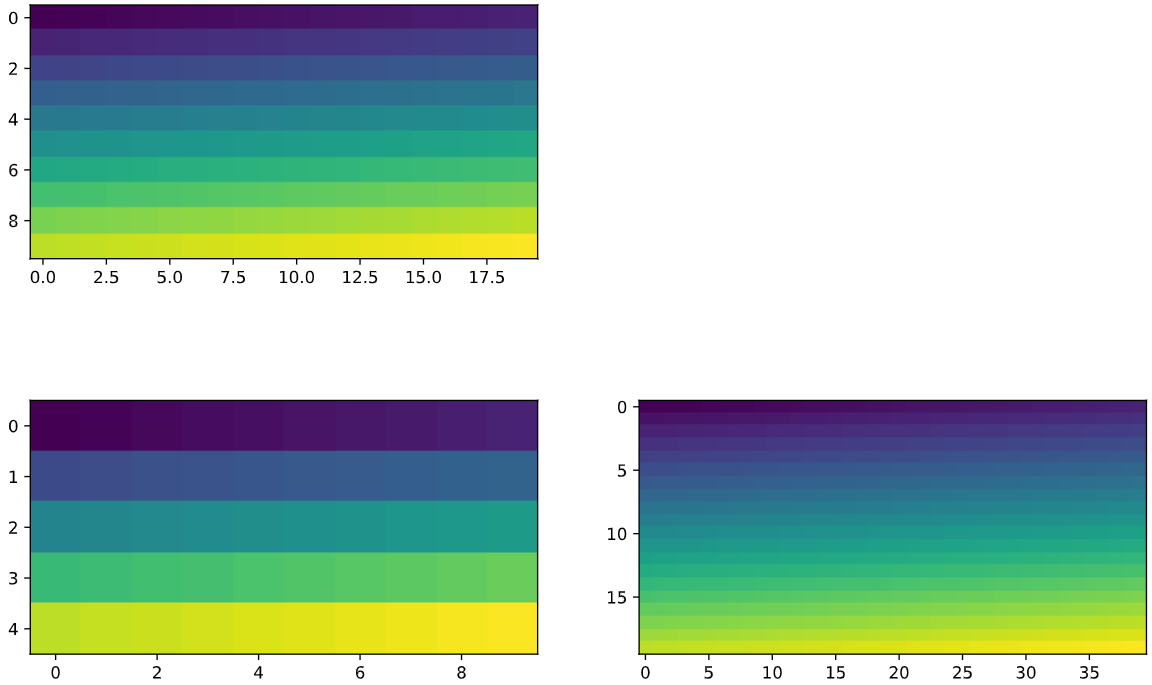[Python scipy] Augmentation / réduction de l'échelle des données 2D
Livre de vocabulaire. Réimprimer beaucoup car il est difficile de rechercher à chaque fois. Il existe une URL d'origine.
Parfois, cela devient déroutant:
--Upscale: résolution grossière --Downscale: résolution plus fine
L'interpolation des valeurs est résumée ici: [SciPy.org: Interpolation (scipy.interpolate)] (https://docs.scipy.org/doc/scipy-0.14.0/reference/interpolate.html)
Parmi ceux-ci, celui qui est souvent utilisé pour le haut de gamme / le bas de gamme
- interp2d
- Seulement 2 dimensions.
kind= ‘linear’, ‘cubic’, ‘quintic’
- RegularGridInterpolator
--Peut être utilisé dans d'autres dimensions que 2
--Doit être une "grille régulière" (pas nécessairement espacée régulièrement)
method= 'linear', 'nearest'
- Plus rapide que ʻintrep2d` si c'est bien
Exemple d'utilisation de RegularGridInterpolator
[stackoverflow: Scipy interpolation with masked data?] (https://stackoverflow.com/questions/35807321/scipy-interpolation-with-masked-data) Est facile à comprendre. Dans le cas de MaskedArray, il est plus rapide de convertir le masque lui-même (plutôt que de remplir la partie masquée avec np.nan).
import numpy as np
from scipy import interpolate
def conv_resol(arr, newshape, *args, **kwargs):
'''
Args:
arr [2d ndarray or MaskedArray]
newshape [tuple of int]
*args, **kwargs: for interpolate.RegularGridInterpolator
'''
nx0, ny0 = arr.shape
nx1, ny1 = newshape
x0 = np.linspace(0, 1, nx0)
y0 = np.linspace(0, 1, ny0)
x1 = np.linspace(0, 1, nx1)
y1 = np.linspace(0, 1, ny1)
x1, y1 = np.meshgrid(x1, y1) # x1 [ny1,nx1], y1 [ny1, nx1]
xy1 = np.array((x1, y1)).T # xy1 [nx1, ny1, 2]
arr1 = interpolate.RegularGridInterpolator((x0, y0), arr, *args, **kwargs)(xy1)
if isinstance(arr, np.ma.MaskedArray):
mask1 = interpolate.RegularGridInterpolator((x0, y0), arr.mask.astype('float'), *args, **kwargs)(xy1) > 0.0
return np.ma.masked_array(arr1, mask=mask1)
return arr1
tester
import matplotlib.pyplot as plt
nx0, ny0 = 10, 20
arr0 = np.arange(nx0 * ny0).reshape(nx0, ny0) * (1.0 / (nx0 * ny0))
nx1, ny1 = 5, 10
arr1 = conv_resol(arr0, (nx1, ny1))
nx2, ny2 = 20, 40
arr2 = conv_resol(arr0, (nx2, ny2))
plt.figure(figsize=(12,8))
plt.subplot(2,2,1)
plt.imshow(arr0, vmin=0.0, vmax=1.0)
plt.subplot(2,2,3)
plt.imshow(arr1, vmin=0.0, vmax=1.0)
plt.subplot(2,2,4)
plt.imshow(arr2, vmin=0.0, vmax=1.0)

Recommended Posts